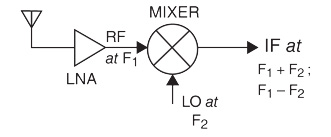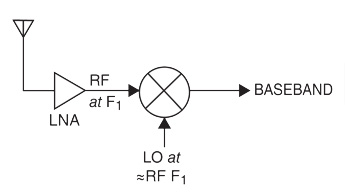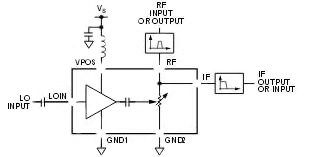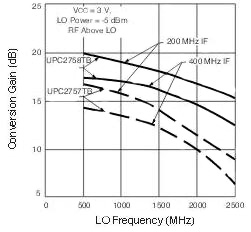The mixer is a key stage of the RF signal chain in the superheterodyne (super) receiver architecture. It allows the receiver to be tuned over a wide frequency band of interest and then convert any desired received signal frequency to a known fixed frequency. This allows the signal of interest to be efficiently processed, filtered and demodulated. The structure of the super structure is elegant and simple, but the actual performance depends on the performance of its constituent functional blocks.
Note that the ubiquitous Superman was developed by the engineering genius Major E.H. Armstrong was in the 1930s and largely replaced his previous receiver design, the super-regenerative design (although it is still used in professional applications today). Subsequently, Armstrong also invented frequency modulation, which is still widely used. Any one of them would make Armstrong a "pioneer and inventor" category, but it is really important to have these three radio-related inventions. For more information on the basics of the mixer, see the TechZone article "Basics of the mixer". In a basic super "single conversion" receiver, the input carrier RF signal is amplified by one or more low noise amplifier (LNA) stages and then enters the mixer (Figure 1). The mixer has two inputs: RF signal and local oscillator (LO). The LO is at a fixed offset from the desired signal to be tuned, and can be set above or below the carrier frequency; there are technical reasons in some designs, why one takes precedence over the other.

Figure 1: The basic superheterodyne architecture mixes the RF signal with the local oscillator and maintains a fixed offset with the amplified RF signal to be tuned to generate a down-conversion, fixed-frequency IF signal, which can then be amplified and demodulated Baseband.
The mixer is a non-linear stage that combines two signals. This nonlinear mixing produces two outputs: one at the sum of the two signal frequencies, and the other at their difference (other and/harmonics are also produced by the nonlinear mixing process, but they are not interesting and easy to filter). There is such a fixed beat frequency output, called an intermediate frequency (IF), which makes the super design so effective. This is because no matter what the specific frequency is tuned, the IF is always at the same frequency. Since the IF frequency is always the same, the IF stage amplifier and subsequent demodulator can be optimized for the performance of a single known frequency.
Next, filter the IF output of the mixer to eliminate any artifacts (as much as possible), and then proceed to the next stage for further amplification and demodulation. Historically, traditional broadcast AM radio used 455 kHz IF, traditional broadcast FM radio used 10.7 MHz, but other professional applications used different IFs.
In addition to the basic single conversion super, there are also double conversion topologies. This is used for higher carrier frequencies, such as 500 MHz or above 1 GHz, to alleviate signal filtering problems and noise problems by optimizing the achievable performance of each stage; the carrier passes through the first stage mixer/LO to reduce it to approximately The first IF of 50-100MHz is then further down-converted to the second IF by the second mixer/LO. This provides designers with greater overall flexibility and relaxes some of the requirements for individual component specifications. (There are even triple conversion receivers in commercial use.) Figure 2: In a double conversion design, the basic super method extends the first down conversion stage for tuning at a higher frequency; the IF output becomes equivalent to a fixed Frequency RF, which is mixed with the LO of the second stage to produce a second IF output.
1. Zero-IF design
Although the LO/IF ultra-precision method is by far the most successfully designed receiver architecture, it is now gaining competition from another method: a zero-IF receiver, also known as a direct receiver-conversion receiver (DCR), The homodyne receiver or synchronous receiver (Figure 3). Here, the LO frequency is set very close to the RF carrier frequency of the desired signal. The mixed output is immediately at baseband and does not require an IF stage.

Figure 3: The zero-IF method uses an LO that is very close to the RF signal and directly downconverts to baseband without an intermediate IF stage.
Although this method theoretically reduces the complexity of the basic circuit, it imposes strict requirements on all stages, including dynamic range, stability, distortion, tuning range and noise. For some carefully selected and designed applications, IC can make zero-IF receivers competitive or superior to super receivers with IF levels.
2. Key mixer parameters
Mixers can be passive (usually built with diodes) or active devices that use transistor gain. As a functional module that collects signals in a wide RF frequency band and down-converts it to a fixed IF frequency, mixers have many requirements for it. Active and passive mixers each provide different combinations of key parameters, all of which are measured in dB, unless otherwise stated:
The third-order intercept point or input cross point (IIP3 or IP3) relates to the effect of the nonlinear product mixer on the linearly amplified signal caused by the third-order nonlinear product term. Two test frequencies within the passband of the mixer are used to evaluate the third-order intercept point; typically, these test frequencies are about 20 to 30 kHz apart. A higher IP3 value (in dBm) indicates a better mixer.
Conversion loss/gain is the ratio of IF output power to RF input power. For passive mixers, this is always the loss (negative dB), usually between -5 and -10 dB. Although it is a measure of the efficiency of a mixer, the problem here is not the efficiency of the DC power supply, but the relatively low RF power level that the mixer sees by it.
The noise figure (NF) is very important because it characterizes the noise added by the mixer and appears at the IF output. This is a concern, because once the in-band noise is added to the signal of interest, it is almost impossible to eliminate, destroy the signal, make demodulation more challenging, and reduce the bit error rate (BER). The typical noise figure is between 0.5 and 3 dB.
Isolation defines the degree to which the mixer prevents the RF or LO input signal energy from reaching the IF output, which can destroy and distort the IF and cause demodulation problems and errors. It is the ratio of RF or LO input to leakage IF output.
The dynamic range measures the ratio of the maximum signal level to the minimum signal level that the mixer can handle, and still provides an IF signal that meets the specifications. Depending on the expected RF input, the system may require medium (50 dB) or wide dynamic range (100 dB).
These are just the performance parameters related to the top mixer. Others include image rejection, gain compression, DC offset and 1 dB compression point.
3. Wide range of available mixers
Mixer vendors include traditional analog IC vendors with RF expertise, as well as RF-centric vendors that develop IC and discrete mixers. Since these two groups look at mixer performance from different directions, they have different areas of focus in terms of priorities and trade-offs, as well as common aspects.
IC supplier ADI introduced the ADL5350, which is a GaAs pHEMT single-ended passive mixer with integrated LO buffer amplifier (Figure 4).

Figure 4: The ADL5350 passive mixer includes an active LO amplifier to simplify the operation and requirements of LO signal generation.
This broadband device can handle frequencies from 750 MHz to 4 GHz and is designed for cellular base stations with different modulation types and standards. The buffer allows the user to provide a low level LO, which simplifies the design. The conversion loss is 6.8 dB, the noise figure is 6.5 dB, and the IP3 is 25 dB. Due to the frequencies involved, the ADL5350 uses an 8 VFDFN exposed pad, chip-scale package. (It can also be used for the supplementary process of up-conversion, but this is another story.)
CEL (formerly California Eastern Laboratory) provides UPC2757 silicon chip MMIC (monolithic microwave IC) for RF input from 0.1 to 2.0 GHz and IF from 20 to 300 MHz (Figure 6).

Figure 6: CEL's UPC2757 series includes basic active mixers for RF inputs between 0.1 and 2.0 GHz.
UPC2757TB is optimized for low power consumption, while UPC2758TB is optimized for low distortion. For each IC, the conversion gain is a function of the LO frequency (Figure 7).

Figure 7: The conversion gain of CEL's UPC2757 MMIC varies with LO frequency; two main family members provide basic choices for power consumption and distortion.
These are just two examples. Mixers are available from many suppliers; the equipment can be used for various RF and LO frequencies, as well as different power levels and performance parameters. The designer’s decision-making process first lists the basic frequency requirements and the required values for other mixer properties, as well as any flexibility or trade-offs that may exist in any of these factors.
Our other product:




















